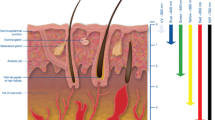Abstract
A simple two-component model is worked out to investigate pulsed laser-induced fluorescence in complex organic samples, like biological tissues, optically thick at the excitation wavelength. Expression for emitted fluorescence signal is obtained. Saturation process is shown to be determined not only by fluorophores excited by the laser, but non-fluorescent chromophores with overlapping absorption band as well. For homogeneous samples the forms of saturation curves are determined by fluorophore’s features. Experimental saturation curves of bulk paper and mice tissues ultraviolet pulsed laser-induced fluorescence are discussed considering this model. For the ns and shorter laser pulse durations with wavelength in 200–300 nm region, pulse energy density should be less than 200 μJ/cm2 for correct quantitative comparison of fluorescence spectra of biological tissues with primarily tryptophan fluorescence.






Similar content being viewed by others
References
Parker CA, Rees WT (1960) Correction of fluorescence spectra and measurement of fluorescence quantum efficiency. Analyst 85(1013):587–600
Richards-Kortum R, Sevick-Muraca E (1996) Quantitative optical spectroscopy for tissue diagnosis. Annu Rev Phys Chem 47(1):555–606
Gutmann E, Erfurth F, Drewitz A, Scheibe A, Meinke MC (2016) UV fluorescence detection and spectroscopy in chemistry and life sciences. In: Kneissl M, Rass J (eds) III-nitride ultraviolet emitters. Springer series in materials science, vol 227. Springer, Cham
Subbotin DV, Larionov PM, Sergeevichev DS et al (2009) Morphological evaluation of cytoarchitectonics of aortic graft at the biotechnological stage with analysis of changes in laser-induced fluorescence spectra. Bull Exp Biol Med 148(4):684–688
Larionov PM, Malov AN, Maslov NA, Orishich AM, Titov AT, Shchukin VS (2000) Influence of mineral components on laser-induced fluorescence spectra of calcified human heart-valve tissues. Appl Opt 39(22):4031–4036
Maslov NA, Larionov PM, Rozhin IA, Druzhinin IB, Chernykh VV (2016) Laser-induced fluorescence spectroscopy of the secondary cataract. Opt Spectrosc 120(6):983–987
Fereidouni F, Mitra AD, Demos S, Levenson R (2015) Microscopy with UV surface excitation (MUSE) for slide-free histology and pathology imaging. Proc. SPIE, optical biopsy XIII: toward real-time spectroscopic imaging and diagnosis 9318:93180F
Larionov PM, Malov AN, Maslov NA, Orishich AM (2000) Application of the LIF method to studying the UV-radiation effect on biological tissues. Atmos Oceanic Opt 13:279–282
Richards-Kortum R, Rava RP, Cothren R et al (1989) A model for extraction of diagnostic information from laser induced fluorescence spectra of human artery wall. Spectrochim Acta A: Mol Spectrosc 45(1):87–93
Chu SC, Chiang HK (2010) Monte Carlo simulation of fluorescence spectra of normal and dysplastic cervical tissues for optimizing excitation/receiving arrangements. Appl Spectrosc 64(7):708–713
Maslov DV, Ostroumov EE, Fadeev VV (2006) Saturation fluorimetry of complex organic compounds with a high local concentration of fluorophores (by the example of phytoplankton). Quantum Electron 36:163–168
Vidal F, Laville S, Goueguel C, Loudyi H, Rifai K, Chaker M, Sabsabi M (2010) A simple model of laser-induced fluorescence under arbitrary optical thickness conditions at the excitation wavelength. J Quant Spectrosc Radiat Transf 111(17-18):2528–2533
Lin B, Urayama S, Saroufeem RMG, Matthews DL, Demos SG (2009) Real-time microscopic imaging of esophageal epithelial disease with autofluorescence under ultraviolet excitation. Opt Express 17:12502–12509
Funding
This work was supported by Siberian Branch of Russian Academy of Sciences (integration grant 0323-2018-0029).
Author information
Authors and Affiliations
Corresponding author
Rights and permissions
About this article
Cite this article
Maslov, N.A. Ultraviolet Pulsed Laser-Induced Fluorescence Nonlinearity in Optically Thick Organic Samples. J Fluoresc 28, 689–693 (2018). https://doi.org/10.1007/s10895-018-2232-5
Received:
Accepted:
Published:
Issue Date:
DOI: https://doi.org/10.1007/s10895-018-2232-5




